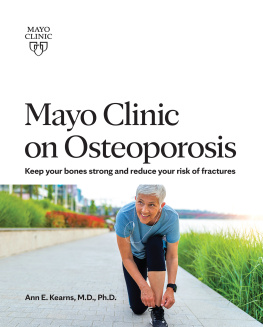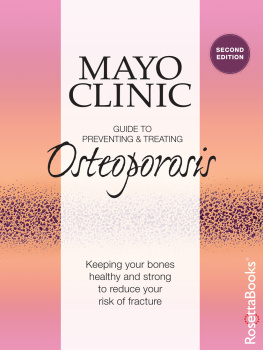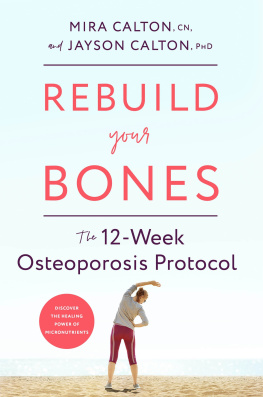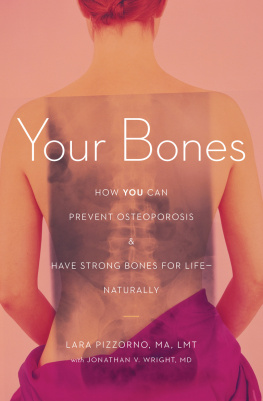
Mayo Clinic Press
Medical Editor Ann E. Kearns, M.D., Ph.D.
Publisher Daniel J. Harke
Editor in Chief Nina E. Wiener
Managing Editor Anna L. Cavallo
Art Director Stewart J. Koski
Production Design Gunnar T. Soroos
Illustration Mayo Clinic Media Support Services, Mayo Clinic Medical Illustration and Animation
Photography Mayo Clinic Media Support Services
Editorial Research Librarians Abbie Y. Brown, Edward (Eddy) S. Morrow Jr., Erika A. Riggin, Katherine (Katie) J. Warner
Copy Editors Miranda M. Attlesey, Alison K. Baker, Nancy J. Jacoby, Julie M. Maas
Indexer Steve Rath
Contributors
Ejigayehu G. Abate, M.D.
Bart L. Clarke, M.D.
Matthew T. Drake, M.D., Ph.D.
Kurt A. Kennel, M.D.
Stephen (Andy) A. Sems, M.D.
Mehrsheed Sinaki, M.D., M.S.
Ericka E. Tung, M.D., M.P.H.
Laura M. Waxman
Robert A. Wermers, M.D.
Katherine A. Zeratsky, RDN, LD
Published by Mayo Clinic Press
2021 Mayo Foundation for Medical Education and Research (MFMER)
MAYO, MAYO CLINIC and the Mayo triple-shield logo are marks of Mayo Foundation for Medical Education and Research. All rights reserved. No part of this book may be reproduced, stored in a retrieval system, or transmitted, in any form or by any means, electronic, mechanical, photocopying, recording or otherwise, without the prior written permission of the publisher.
The information in this book is true and complete to the best of our knowledge. This book is intended only as an informative guide for those wishing to learn more about health issues. It is not intended to replace, countermand or conflict with advice given to you by your own physician. The ultimate decision concerning your care should be made between you and your doctor. Information in this book is offered with no guarantees. The author and publisher disclaim all liability in connection with the use of this book.
From time to time, Mayo Clinic or a Mayo Clinic physician may have a financial interest in an invention, technology, company or product mentioned in Mayo Clinic books. Dr. Andy Sems, a contributing editor of , receives royalties for his work as a designer of an intramedullary nail, a hip fracture repair technology referenced in that chapter.
For bulk sales to employers, member groups and health-related companies, contact Mayo Clinic, 200 First St. SW, Rochester, MN 55905, or send an email to .
ISBN 978-1-945564-38-3
Library of Congress Control Number: 2020938350
Some images within this content were created prior to the COVID-19 pandemic and may not demonstrate proper pandemic protocols. Please follow all recommended CDC guidelines for masking and social distancing.
Contents
Preface
Bones form the physical foundation of the body, your skeleton. As with many aspects of health, its easy to pay little attention to your skeleton until a problem occurs, such as a broken bone. Then youre keenly aware of how your daily routine depends on the health of this foundation.
Building a strong skeletal foundation begins in childhood with good nutrition and exercise. In adulthood, maintaining strong bones means continuing these good habits and avoiding bad habits, like smoking and other substance abuse. However, even with a healthy lifestyle, the bones change with age. They may also be affected by other health problems. These changes can lead to osteoporosis, a weakening of your bones. With osteoporosis, broken bones (fractures) may result from simple activities like a cough, an exhuberant hug or lifting a grandchild.
My passion is helping people avoid broken bones so they can enjoy their lives to the fullest. Even after developing osteoporosis, you can take action to limit or reverse bone loss. Every day in my practice I see people who have had weakened and broken bones, and I work with them to design a treatment program to lower the risk of more fractures.
With contributions from my colleagues, Mayo Clinic on Osteoporosis brings the passion and expertise of Mayo Clinic health care providers to the page. This book covers state of the art, proven medical strategies to prevent and treat osteoporosis, incorporating recent advances in imaging and medications. It also provides the latest information and guidance on promoting bone health through nutrition, exercise and your lifestyle.
This book is organized into three parts. In , youll learn how osteoporosis develops through an imbalanced bone maintenance system. These first chapters also cover risk factors for osteoporosis, fractures and falls, and bone density testing to help you understand the disease and how its diagnosed.
focuses on understanding and improving bone health in men.
reviews what to expect if you do experience a fracture and how to optimize your recovery.
You may be reading this book to inform yourself because you have osteoporosis or low bone mass or because someone in your life does. Either way, my hope is you will gain confidence in what you can do, or help others do, to keep the skeletal foundation standing strong.
 Ann E. Kearns, M.D., Ph.D.
Ann E. Kearns, M.D., Ph.D. is an endocrinologist at Mayo Clinic in Rochester, Minnesota, and an associate professor at Mayo Clinic College of Medicine and Science. A graduate of Brown University and the University of Chicago Pritzker School of Medicine, she completed her residency in Chicago and a fellowship in endocrinology at Harvard Universitys Massachusetts General Hospital. Since joining Mayo Clinic in 1998, Dr. Kearns has been dedicated to improving osteoporosis care and secondary fracture prevention. She has also contributed to national efforts to close the gap between recommendations and typical care, working toward better diagnosis and treatment of people with osteoporotic fractures.
Part 1 Understanding osteoporosis
Chapter 1 What is osteoporosis?
You may not think of your bones as being alive, but they are. Every day, your body breaks down old bone and replaces it with new. As you get older, however, you lose more bone than you gain. If you lose too much, you can develop the bone disease osteoporosis.
Osteoporosis causes bones to become weak, brittle and prone to fracture. The word osteoporosis means porous bones. Due to this loss of bone tissue, bones that were once dense and strong may be unable to withstand the stress of even normal activity, such as bending over or twisting to look behind you.
Having some bone loss is a natural part of aging, similar to getting gray hair or developing wrinkles. However, losing several inches of height goes beyond whats considered healthy aging. And it certainly isnt normal to break a bone from coughing or receiving a hug.
But thats precisely what can happen if youre one of about 54 million people in the United States who have osteoporosis or are at high risk of it due to low bone mass.
Wondering about weak vs. strong bones, or bone mass vs. bone strength? Here are some key terms.
- Bone mass is the total amount of bone tissue you have in your skeleton.
- Bone density refers to how tightly that tissue is packed within a given area of bone.
- Bone strength refers to the ability of bone to withstand stress and is dependent on bone quality, including mass and density as well as the structure.
Next page







 Ann E. Kearns, M.D., Ph.D. is an endocrinologist at Mayo Clinic in Rochester, Minnesota, and an associate professor at Mayo Clinic College of Medicine and Science. A graduate of Brown University and the University of Chicago Pritzker School of Medicine, she completed her residency in Chicago and a fellowship in endocrinology at Harvard Universitys Massachusetts General Hospital. Since joining Mayo Clinic in 1998, Dr. Kearns has been dedicated to improving osteoporosis care and secondary fracture prevention. She has also contributed to national efforts to close the gap between recommendations and typical care, working toward better diagnosis and treatment of people with osteoporotic fractures.
Ann E. Kearns, M.D., Ph.D. is an endocrinologist at Mayo Clinic in Rochester, Minnesota, and an associate professor at Mayo Clinic College of Medicine and Science. A graduate of Brown University and the University of Chicago Pritzker School of Medicine, she completed her residency in Chicago and a fellowship in endocrinology at Harvard Universitys Massachusetts General Hospital. Since joining Mayo Clinic in 1998, Dr. Kearns has been dedicated to improving osteoporosis care and secondary fracture prevention. She has also contributed to national efforts to close the gap between recommendations and typical care, working toward better diagnosis and treatment of people with osteoporotic fractures.